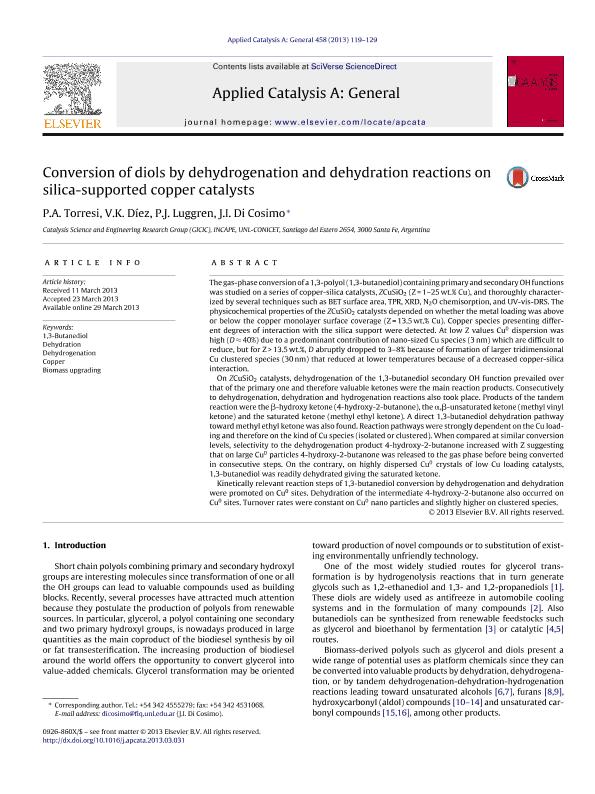Mostrar el registro sencillo del ítem
dc.contributor.author
Torresi, Pablo Antonio

dc.contributor.author
Diez, Veronica Karina

dc.contributor.author
Luggren, Pablo Jorge

dc.contributor.author
Di Cosimo, Juana Isabel

dc.date.available
2019-06-21T00:44:34Z
dc.date.issued
2013-05
dc.identifier.citation
Torresi, Pablo Antonio; Diez, Veronica Karina; Luggren, Pablo Jorge; Di Cosimo, Juana Isabel; Conversion of diols by dehydrogenation and dehydration reactions on silica-supported copper catalysts; Elsevier Science; Applied Catalysis A: General; 458; 5-2013; 119-129
dc.identifier.issn
0926-860X
dc.identifier.uri
http://hdl.handle.net/11336/78598
dc.description.abstract
The gas-phase conversion of a 1,3-polyol (1,3-butanediol) containing primary and secondary OH functions was studied on a series of copper-silica catalysts, ZCuSiO2 (Z = 1-25 wt.% Cu), and thoroughly characterized by several techniques such as BET surface area, TPR, XRD, N2O chemisorption, and UV-vis-DRS. The physicochemical properties of the ZCuSiO 2 catalysts depended on whether the metal loading was above or below the copper monolayer surface coverage (Z = 13.5 wt.% Cu). Copper species presenting different degrees of interaction with the silica support were detected. At low Z values Cu0 dispersion was high (D ≈ 40%) due to a predominant contribution of nano-sized Cu species (3 nm) which are difficult to reduce, but for Z > 13.5 wt.%, D abruptly dropped to 3-8% because of formation of larger tridimensional Cu clustered species (30 nm) that reduced at lower temperatures because of a decreased copper-silica interaction. On ZCuSiO2 catalysts, dehydrogenation of the 1,3-butanediol secondary OH function prevailed over that of the primary one and therefore valuable ketones were the main reaction products. Consecutively to dehydrogenation, dehydration and hydrogenation reactions also took place. Products of the tandem reaction were the β-hydroxy ketone (4-hydroxy-2-butanone), the α,β- unsaturated ketone (methyl vinyl ketone) and the saturated ketone (methyl ethyl ketone). A direct 1,3-butanediol dehydration pathway toward methyl ethyl ketone was also found. Reaction pathways were strongly dependent on the Cu loading and therefore on the kind of Cu species (isolated or clustered). When compared at similar conversion levels, selectivity to the dehydrogenation product 4-hydroxy-2-butanone increased with Z suggesting that on large Cu0 particles 4-hydroxy-2-butanone was released to the gas phase before being converted in consecutive steps. On the contrary, on highly dispersed Cu 0 crystals of low Cu loading catalysts, 1,3-butanediol was readily dehydrated giving the saturated ketone. Kinetically relevant reaction steps of 1,3-butanediol conversion by dehydrogenation and dehydration were promoted on Cu0 sites. Dehydration of the intermediate 4-hydroxy-2-butanone also occurred on Cu0 sites. Turnover rates were constant on Cu0 nano particles and slightly higher on clustered species.
dc.format
application/pdf
dc.language.iso
eng
dc.publisher
Elsevier Science

dc.rights
info:eu-repo/semantics/openAccess
dc.rights.uri
https://creativecommons.org/licenses/by-nc-sa/2.5/ar/
dc.subject
1,3-Butanediol
dc.subject
Biomass Upgrading
dc.subject
Copper
dc.subject
Dehydration
dc.subject
Dehydrogenation
dc.subject.classification
Otras Ingeniería Química

dc.subject.classification
Ingeniería Química

dc.subject.classification
INGENIERÍAS Y TECNOLOGÍAS

dc.title
Conversion of diols by dehydrogenation and dehydration reactions on silica-supported copper catalysts
dc.type
info:eu-repo/semantics/article
dc.type
info:ar-repo/semantics/artículo
dc.type
info:eu-repo/semantics/publishedVersion
dc.date.updated
2019-06-19T12:20:11Z
dc.journal.volume
458
dc.journal.pagination
119-129
dc.journal.pais
Países Bajos

dc.journal.ciudad
Amsterdam
dc.description.fil
Fil: Torresi, Pablo Antonio. Consejo Nacional de Investigaciones Científicas y Técnicas. Centro Científico Tecnológico Conicet - Santa Fe. Instituto de Investigaciones en Catálisis y Petroquímica "Ing. José Miguel Parera". Universidad Nacional del Litoral. Instituto de Investigaciones en Catálisis y Petroquímica "Ing. José Miguel Parera"; Argentina
dc.description.fil
Fil: Diez, Veronica Karina. Consejo Nacional de Investigaciones Científicas y Técnicas. Centro Científico Tecnológico Conicet - Santa Fe. Instituto de Investigaciones en Catálisis y Petroquímica "Ing. José Miguel Parera". Universidad Nacional del Litoral. Instituto de Investigaciones en Catálisis y Petroquímica "Ing. José Miguel Parera"; Argentina
dc.description.fil
Fil: Luggren, Pablo Jorge. Consejo Nacional de Investigaciones Científicas y Técnicas. Centro Científico Tecnológico Conicet - Santa Fe. Instituto de Investigaciones en Catálisis y Petroquímica "Ing. José Miguel Parera". Universidad Nacional del Litoral. Instituto de Investigaciones en Catálisis y Petroquímica "Ing. José Miguel Parera"; Argentina
dc.description.fil
Fil: Di Cosimo, Juana Isabel. Consejo Nacional de Investigaciones Científicas y Técnicas. Centro Científico Tecnológico Conicet - Santa Fe. Instituto de Investigaciones en Catálisis y Petroquímica "Ing. José Miguel Parera". Universidad Nacional del Litoral. Instituto de Investigaciones en Catálisis y Petroquímica "Ing. José Miguel Parera"; Argentina
dc.journal.title
Applied Catalysis A: General

dc.relation.alternativeid
info:eu-repo/semantics/altIdentifier/doi/http://dx.doi.org/10.1016/j.apcata.2013.03.031
Archivos asociados
